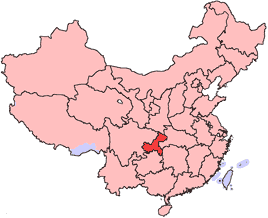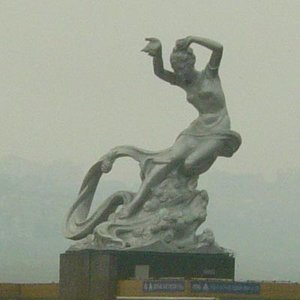Chongqing
|
|
| Abbreviation: 渝 (pinyin: Yú) | |

| |
| Origin of Name | 重 chóng - again 庆 qìng - celebrate "double celebration" |
| Administration Type | Municipality |
| Seat of Government | Yuzhong Qu |
| CPC Chongqing Committee Secretary | Huang Zhendong |
| Mayor | Wang Hongju |
| Area | 82,300 km² (26th) |
| Population (2002) - Metropolitan area - Density | 31,070,000 (20th) approx. 4 million 378/km² (10th) |
| GDP (2003) - per capita | 225.1 billion ¥ (23rd) 7190 ¥ (20th) |
| Major Nationalities (2000) | Han - 94% Tujia - 5% Miao - 2% |
| City tree | Ficus lacor |
| City flower | Camellia (Camellia japonica) |
| County-level divisions | 40 |
| Township-level divisions | 1259 |
| Postal Code | 400000 - 409900 |
| Area Code | 23 |
| License Plate Prefixes | 渝A, B, C, F, G, H Details |
| ISO 3166-2 | CN-50 |
Chongqing (Template:Zh-stpw; Postal System Pinyin: Chungking; literally "Double Celebration") is the largest and most populous of the People's Republic of China's four provincial-level municipalities, and the only one in the less densely populated western half of China. The municipality of Chongqing has a population of 32,355,000 (2004), most of them living outside of the urban area of Chongqing proper, over hundreds of miles of farmland. The population of the urban area of Chongqing proper was estimated at 3.4 million in 2004, ranking approximately as the 10th largest urban area of China. Including the unregistered migrants from the countryside, the population of the urban area could be as high as 7.5 million.
The municipal abbreviation, Yu (渝), was approved by the State Council on April 18, 1997. Yu had previously been used by the Kuomintang. It is the old name of a part of the Jialing River that runs through Chongqing with the Yangtze.
The urban area of Chongqing proper (重庆市区) consists of the district of Yuzhong (渝中区, i.e. "central Chongqing district"), the central and most densely populated district, where government offices are located, as well as the districts of Nan'an (南岸区, i.e. "southern bank district") Jiangbei (江北区, i.e. "north of the river district"), Shapingba (沙坪坝区), Jiulongpo (九龙坡区), and Dadukou (大渡口区).
| Contents |
History
Chongqing is said to be the semi-mythical State of Ba (巴國) that began in 11th century BC, when the Ba people began living here until they were destroyed by the State of Qin in 316 BC. The Qin emperor ordered a new city to be constructed, called Jiang (江州) and Chu Prefecture (楚州).
In 581 AD (Sui Dynasty), Chongqing was renamed to Yu Prefecture (渝州).
In 1102, the city was renamed Gong Prefecture.
In 1189, when Prince Zhao Dun of the Southern Song Dynasty was first made a king then crowned as Emperor Guangzong, he commented that it was "double/repeated happy celebration" (雙重喜慶), so renamed Yu Prefecture to Chongqing Subprefecture.
In 1362 (Yuan Dynasty), Ming Yuzhen, a peasant rebel leader, established Daxia Kingdom at Chongqing for a short time.
In 1621, another short-lived kingdom of Daliang was established there.
In 1891, Chongqing became the first inland commerce port open to foreigners.
Since 1929, Chongqing was a municipality of the Republic of China. Chongqing was the provisional capital of the government of Generalissimo Chiang Kai-shek during World War II (Second Chinese-Japanese War) and was heavily bombed by the Japanese Air Force.
In 1954, the municipality was reduced to a provincial city of the People's Republic.
For three years, Chongqing had been a sub-provincial city of Sichuan Province, until March 14, 1997, as decided in the Eighth National People's Congress, the original Chongqing City was merged with the neighbouring Fuling, Wanxian, and Qianjiang that had been governed by Chongqing City on behalf of the province since September of the previous year. These four prefecture-level entities were all abolished as distinct administrative divisions and formed one new Chongqing Municipality that contained 30,020,000 people in their 43 former counties (without intermediate political levels). The first official ceremony took place on June 18 of that year.
In March 14, 1997, the original Chongqing City was promoted to the status of Municipality. The municipality was formed to spearhead China's effort to develop its western regions as well as to coordinate the resettlement of refugees from the Three Gorges Dam project.
Subdivisions
Chonqing3.jpg
Chonqing5.jpg
Chonqing6.jpg
Chonqing7.jpg
The municipality is divided in to 40 county-level subdivisions (3 were abolished since 1997): 15 districts, 4 county-level cities, and 21 counties.
The origin column indicates which city the entity belonged to prior to the 1997 comglomeration of Chongqing with Fuling, Wanxian (now Wanzhou), and Qianjiang.
| Pinyin | Hanzi | Origin |
|---|---|---|
| Districts: | ||
| Banan | 巴南区 | Chongqing |
| Beibei | 北碚区 | Chongqing |
| Changshou | 长寿区 | Chongqing |
| Dadukou | 大渡口区 | Chongqing |
| Fuling | 涪陵区 | Fuling |
| Jiangbei | 江北区 | Chongqing |
| Jiulongpo | 九龙坡区 | Chongqing |
| Nan'an | 南岸区 | Chongqing |
| Qianjiang | 黔江区 | Qianjiang |
| Shapingba | 沙坪坝区 | Chongqing |
| Shuangqiao | 双桥区 | Chongqing |
| Wansheng | 万盛区 | Chongqing |
| Wanzhou | 万州区 | Wanxian |
| Yubei | 渝北区 | Chongqing |
| Yuzhong | 渝中区 | Chongqing |
| County-level cities: | ||
| Hechuan | 合川市 | Chongqing |
| Jiangjin | 江津市 | Chongqing |
| Yongchuan | 永川市 | Chongqing |
| Nanchuan | 南川市 | Fuling |
| Counties: | ||
| Bishan | 璧山县 | Chongqing |
| Chengkou | 城口县 | Wanxian |
| Dazu | 大足县 | Chongqing |
| Dianjiang | 垫江县 | Fuling |
| Fengdu | 丰都县 | Fuling |
| Fengjie | 奉节县 | Wanxian |
| Kai | 开县 | Wanxian |
| Liangping | 梁平县 | Wanxian |
| Qijiang | 綦江县 | Chongqing |
| Rongchang | 荣昌县 | Chongqing |
| Tongliang | 铜梁县 | Chongqing |
| Tongnan | 潼南县 | Chongqing |
| Wulong | 武隆县 | Fuling |
| Wushan | 巫山县 | Wanxian |
| Wuxi | 巫溪县 | Wanxian |
| Yunyang | 云阳县 | Wanxian |
| Zhong | 忠县 | Wanxian |
| Autonomous counties: | ||
| Pengshui | 彭水苗族土家族自治县 | Qianjiang |
| Shizhu | 石柱土家族自治县 | Qianjiang |
| Xiushan | 秀山土家族自治县 | Qianjiang |
| Youyang | 酉阳土家族苗族自治县 | Qianjiang |
Geography
- Geographic coordinates: 105°17'-110°11' East, 28°10'-32°13' North
- Annual average temperature: 18 °C (64 °F)
- Temperature range: 6 to 29 °C
- Total annual daylight hours: 1000-1200
- Annual precipitation: 1000-1400 mm
- Neighbours: Hubei (east), Hunan (east), Guizhou (south), Sichuan (west), Shaanxi (north)
Located on the edge of the Yungui Plateau, Chongqing is intersected by the Jialing River and the upper reaches of the Yangtze. It contains Daba Shan in the north, Wu Shan in the east, Wuling Shan in the southeast, and Dalou Mountain to the south.
The city is very hilly and is the only major metropolitan area in China without significant numbers of bicycles.
Economy

Located at the head of the reservoir behind the Three Gorges Dam, Chongqing is planned to be the beachhead for the development of the western part of the country. Massive public works are currently under way in the city, including overhead and surface commuter rail lines connecting the many districts of the city.
Fairly recently, with central government policies aimed at further developing Western China, Chongqing has become a "Gateway to the west". Foreign investment in the city is growing at a fast pace.
The GDP was 225.1 billion RMB (ca. 27 billion USD) and per capita was 9038 RMB (ca. 1090 USD) in 2003, ranking no. 303 among 659 Chinese cities.
Climate
ChongqingStLights.jpg
The climate is semi-tropical, with the two-season monsoonal variations typical of south asia. During World War II the frequent dense fogs were welcomed for their protection from Japanese aircraft bombing attacks.
As is true of most of China, severe air pollution is frequently present, largely as a result of the burning of coal without pollution controls, both for industrial processess and for the production of electric power.
Landmarks
- The city is home to one of the largest public assembly buildings in China, the Great Hall of the People, built in modern times but in the classic Tang dynasty style - as a large circular building. This is adjacent to the densely populated and hilly central district, with narrow streets and pedestrian only walkways.
- There is a museum at the World War II headquarters of General "Vinegar Joe" Stilwell. The preservation and presentation of the materials here reflect the long and historic affection between China and the U.S., despite the global frictions between their respective governments of the late 20th century.
- A giant ferris wheel offers spectacular views of the metropolitain area.
- A modern and well stocked zoo exhibits many national and regional animals, including the Giant Panda and the extremely rare South China Tiger.
City tree
The city's tree is the evergreen magnolia (magnolia delavayi) abundant in street plantings, with the tulip-like shape of its mature unopened blooms repeated in street lights.
Colleges and Universities
- Chongqing University (重庆大学) (founded in 1929)
- Southwest China Normal University (西南师范大学) (founded in 1906)
- Third Military Medical University (第三军医大学)
- Chongqing Technology and Business University (重庆工商大学)
- Southwest Agricultural University (西南农业大学)
- Chongqing Normal University (重庆师范大学)
- Southwest Politics & Law University (西南政法大学)
- Sichuan International Studies University (四川外语学院)
- Sichuan Fine Arts Institute (四川美术学院)
- Chongqing Jiaotong University (重庆交通学院)
- Chongqing University of Posts and Telecommunications (重庆邮电学院)
- Chongqing Institute of Technology (重庆工学院)
- Western Chongqing University (渝西学院)
- Chongqing Three Gorges University (重庆三峡学院)
- Fuling Teachers College (涪陵师范学院)
Note: Institutions without full-time bachelor programs are not listed.
Astronomical phenomena
The previous total solar eclipse as seen from Chongqing (downtown) was Solar eclipse of 1824-Jun-26 (June 27, 1824).
The next total solar eclipse as seen from Chongqing (downtown) will be Solar eclipse of 2009-Jul-22 (July 22, 2009).
Miscellaneous
Professional sports teams in Chongqing include:
External links
- Official site (http://www.cq.gov.cn) (in Simplified Chinese and English)
- District map (http://www.westtour.net/cq/ditu.htm) / Version 2 (http://www.chinacity.net/zgcs/chongqing/page3.htm) (in Simplified Chinese)
- City centre map (http://www.9654.com/m/cq.htm)
- Visit Chongqing (http://www.visitcq.net) (in Simplified Chinese): Tourism
de:Chongqing
es:Chongqing
fr:Chongqing
ja:重慶市
pl:Czungcing
fi:Chongqing
nl:Chongqing
pt:Chongqing
sv:Chongqing
zh-cn:重庆
| Province-level divisions administered by the People's Republic of China | Missing image PRC_flag_large.png Flag of the People's Republic of China | |||||||||||
| ||||||||||||

